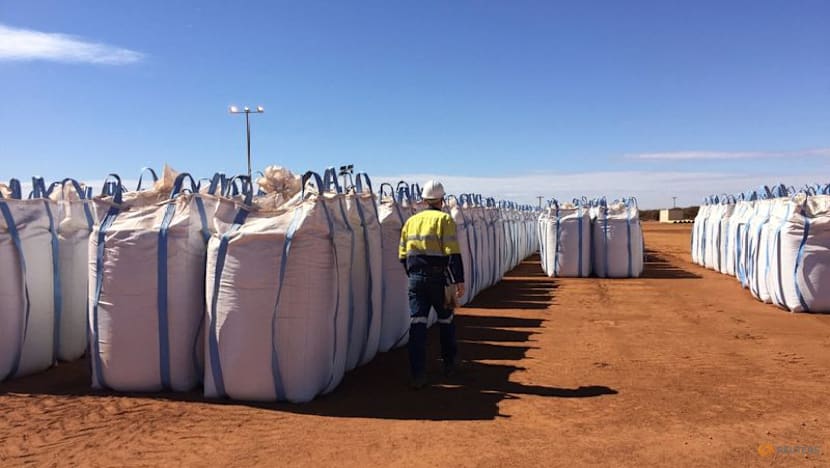Commentary: Malaysia has something great powers want
With a mix of fortune and effort, Malaysia has what it takes to emerge as a consequential middle power, says political analyst James Chai.

File photo of a Lynas Corp worker walking past sacks of rare earth concentrate waiting to be shipped to Malaysia, at Mount Weld, northeast of Perth, Australia. (Photo: Reuters/Melanie Burton)

This audio is generated by an AI tool.
KUALA LUMPUR: When Chinese President Xi Jinping visited Malaysia in April, the symbolism was overpowering. It was Mr Xi’s first visit to Malaysia in 12 years; his last, in 2013, had seen both countries upgrade ties to a Comprehensive Strategic Partnership. Malaysia, notably, held the ASEAN chair and served as Country Coordinator for ASEAN-China Dialogue Relations. The visit also came less than a fortnight after US President Donald Trump unveiled his aggressive “Liberation Day” reciprocal tariffs.
In a time of geopolitical uncertainty, it was clear Mr Xi wanted to position China as Malaysia’s most dependable trade partner, one that acts on win-win outcomes and mutual trust. To demonstrate this, both countries inked 31 memorandums of understanding, ranging from panda research to visa exemptions, railway sector cooperation, trade and investments.
What was most important was not written on paper. The caretaker Minister of Natural Resources and Environmental Sustainability, Johari Ghani, revealed only months later that Mr Xi had offered to help Malaysia develop its rare earth processing capability.
This is significant for a few reasons.
MASTER KEY TO THE VAULT
First, rare earths have skyrocketed in importance due to their ubiquity in core technologies such as data centres, mobile phones, electric vehicles, robots and chips equipment. They also carry significant geopolitical weight. China, which holds a near-monopoly on rare earth refining and processing, has used this as leverage in tariff talks with the US.
Second, Malaysia’s discovery of 16.2 million metric tonnes of rare earth deposits, worth an estimated US$175 billion, puts the country among the top five globally in terms of reserves. Access to Chinese technology for the complex and multi-stage separation process for rare earths, often involving 100 steps guarded by trade secrets, would be equivalent to having the master key to the vault.
Third, China’s dominance in rare earths is likely insurmountable in the medium term due to its technological depth and efficiency lead. Not only did China start early since the 1950s, with the state doubling down under Deng Xiaoping (“The Middle East has oil, China has rare earths”) and Jiang Zemin’s clarion calls, it has continued this dominance by building an entire supply chain within China.
Today, Chinese rare earth capabilities and talents are truly second to none. The US had the Mountain Pass mine but lost its processing technology and talent. Between 1950 and 2020, China filed 25,000 rare earth patents while the US filed less than half that. At the moment, China mines about 60 per cent of the world’s rare earths.
If its cooperation with China materialises, Malaysia might create a two-track rare earth ecosystem - one with Chinese technology and another with Australian firm Lynas, which has a rare earths processing plant in Pahang. Lynas is currently the world’s only commercial producer of heavy rare earths outside of China.
This means that in the coming years, Malaysia could become a battleground in the global race for rare earths, courted by great powers, but beholden to none.
COURTED BY GREAT POWERS
This story, of course, builds on the chips war in which Malaysia has emerged as a “surprise winner”. The world felt, for the first time, Malaysia’s centrality in backend assembly, testing and packaging during COVID-19, when Malaysia’s lockdown halted production at Toyota, Ford, Nissan and General Motors.
Malaysia holds 13 per cent of global backend chip production and 7 per cent of the global market, and supplies around 20 per cent of US semiconductor imports. While Malaysia’s efforts to upgrade to the frontend are still too early to tell, Malaysia will remain a critical node for chips.
Geography works in Malaysia’s favour. The Straits of Malacca is a global trade chokepoint, with 25 per cent of the world’s traded goods and 60,000 annual vessels passing through. Port Klang and Port Tanjung Pelepas are world-class, and the prospect of higher tariffs and volumes (TEUs) is prompting Malaysia’s largest ever IPO.
Compared to regional peers, Malaysia is well-positioned to benefit from shifting global trade dynamics. The Economist recently argued that Malaysia is likely to emerge as one of the winners in Trump’s tariff offensive. Key reasons include more favourable tariff differentials, lower transshipments and lower reliance on American demand.
US tariffs may also accelerate Southeast Asia’s industrial upgrade, as high-value digital services begin shifting towards Asia. Malaysian policies targeting these strategic sectors could allow it to capitalise on this shift.
Leverage, in international politics, is determined by who needs whom more. It is unusual for a middle state like Malaysia to hold assets that great powers want to compete for.
With a mix of fortune (natural resources) and effort (policies and diplomacy), Malaysia has what it takes to emerge as a consequential middle power. The ball is in its court to make the best out of it.
James Chai is a political analyst, columnist and the author of Sang Kancil (Penguin Random House). He writes a monthly column for CNA, published every second Friday.



















